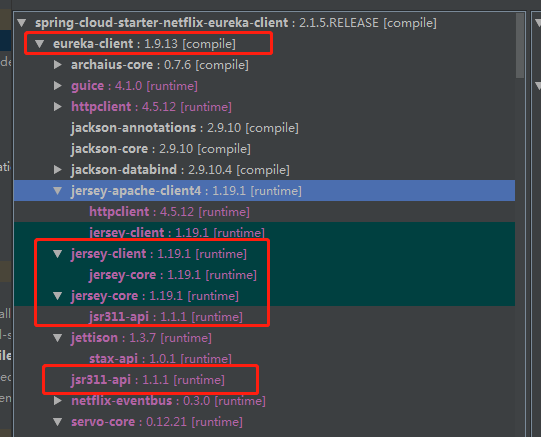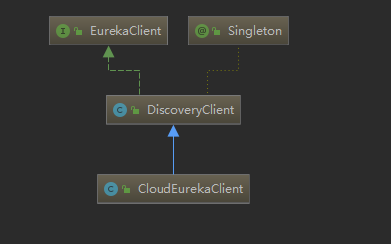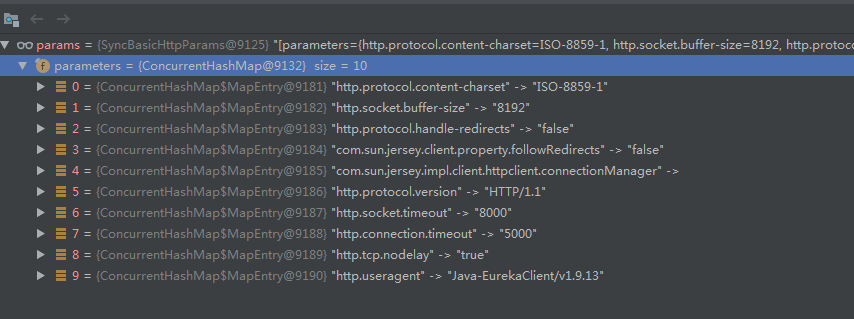曹工说mini-dubbo(2)--分析eureka client源码,想办法把我们的服务提供者注册到eureka server(上)
前言#
eureka是spring cloud Netflix技术体系中的重要组件,主要完成服务注册和发现的功能;那现在有个问题,我们自己写的rpc服务,如果为了保证足够的开放性和功能完善性,那肯定要支持各种注册中心。目前我们只支持redis注册中心,即服务提供者,在启动的时候,将自身的ip+端口信息写入到redis,那,我们是否注册到 eureka中呢?
这个想法可行吗?可行。eureka client 和eureka server间,无非是网络通信,既然是网络通信,那就有网络协议,那我们的应用,只要遵照eureka server的协议来,就可以接入。
另外,eureka server没有采用spring mvc来实现,而是采用了jersey框架,这个框架啥意思呢,可以理解为对Restful的实现。我从网上找了一段(https://www.jianshu.com/p/88f97b90963c):
SpringMVC在开发REST应用时,是不支持JSR311/JSR339标准的。如果想要按照标准行事,最常用的实现了这两个标准的框架就是Jersey和CxF了。但是,因为Jersey是最早的实现,也是JSR311参考的主要对象,所以,可以说Jersey就是事实上的标准(类似Hibernate是JPA的事实上的标准),也是现在使用最为广泛的REST开发框架之一。
因为eureka server采用了jersey,所以eureka client最终也是使用了配套的jersey client来和服务端通信。
所以,eureka client,里面其实依赖了一堆jersey的包:
注意,上面的jersey-client、jersey-core等包,其group id都是这样的:
<dependency>
<groupId>com.sun.jersey</groupId>
<artifactId>jersey-client</artifactId>
<version>1.19.1</version>
<scope>runtime</scope>
</dependency>
但是,不知道为啥,eureka client中,最终并没有完全使用jersey-client,而是使用了
<dependency>
<groupId>com.sun.jersey.contribs</groupId>
<artifactId>jersey-apache-client4</artifactId>
<version>1.19.1</version>
<scope>runtime</scope>
</dependency>
这个包,内部引入了:
<dependency>
<groupId>org.apache.httpcomponents</groupId>
<artifactId>httpclient</artifactId>
<version>4.1.1</version>
</dependency>
这个包,你可以简单理解为,jersey-client变成了一个接口,jersey-apache-client4是它的一个实现,实现里,用了httpClient去实现。
httpClient,没有几个java同学不知道吧?这么做是可行的,因为你最终通信,还是http,不管你服务端框架,是jersey、还是spring mvc、甚至以前的struts,这都不重要。
所以,大家在下面的源码中看到jersey的时候,脑海里可以有这么一张图。从上层到底层的接口,分别是:
CloudEurekaClient
...
DiscoveryClient
...
EurekaClient
...
JerseyClient
...
HttpClient
在此之前,我们还是先分析下eureka client 注册到eureka server的源码。
源码环境#
minidubbo代码和相关博文在:
曹工说mini-dubbo(1)--为了实践动态代理,我写了个简单的rpc框架
https://gitee.com/ckl111/mini-dubbo
代码很简单,不过还是给个代码链接吧:
https://gitee.com/ckl111/all-simple-demo-in-work-1/tree/master/eureka-client
主要就是在pom.xml中,引入:
<dependency>
<groupId>org.springframework.cloud</groupId>
<artifactId>spring-cloud-starter-netflix-eureka-client</artifactId>
</dependency>
然后启动类:
@SpringBootApplication
public class DemoApplication {
public static void main(String[] args) {
SpringApplication.run(DemoApplication.class, args);
}
}
源码分析#
spring.factory支持自动配置#
因为前面的pom,引入了如下jar包:
<dependency>
<groupId>org.springframework.cloud</groupId>
<artifactId>spring-cloud-netflix-eureka-client</artifactId>
</dependency>
该jar包的META-INF\spring.factories中,有如下几行:
org.springframework.boot.autoconfigure.EnableAutoConfiguration=\
org.springframework.cloud.netflix.eureka.config.EurekaClientConfigServerAutoConfiguration,\
org.springframework.cloud.netflix.eureka.config.EurekaDiscoveryClientConfigServiceAutoConfiguration,\
org.springframework.cloud.netflix.eureka.EurekaClientAutoConfiguration,\
org.springframework.cloud.netflix.ribbon.eureka.RibbonEurekaAutoConfiguration,\
org.springframework.cloud.netflix.eureka.EurekaDiscoveryClientConfiguration
我们看到,key是org.springframework.boot.autoconfigure.EnableAutoConfiguration,value是逗号分割的列表,这里面都是需要被自动装配的配置类,其中,我们看第三行的:
org.springframework.cloud.netflix.eureka.EurekaClientAutoConfiguration。
这个类,是自动装配的配置类,我们可以简单一览:
@Configuration
@EnableConfigurationProperties
@ConditionalOnClass(EurekaClientConfig.class)
@Import(DiscoveryClientOptionalArgsConfiguration.class)
@ConditionalOnBean(EurekaDiscoveryClientConfiguration.Marker.class)
@ConditionalOnProperty(value = "eureka.client.enabled", matchIfMissing = true)
@ConditionalOnDiscoveryEnabled
@AutoConfigureBefore({ NoopDiscoveryClientAutoConfiguration.class,
CommonsClientAutoConfiguration.class, ServiceRegistryAutoConfiguration.class })
public class EurekaClientAutoConfiguration {
里面一堆@ConditionalOn***,主要是看该配置类是否生效。
我们不管,这里条件是满足的,所以,看具体java文件里有什么要装配的内容,里面内容较多,我们关注我们需要关注的:
@Bean(destroyMethod = "shutdown")
@ConditionalOnMissingBean(value = EurekaClient.class, search = SearchStrategy.CURRENT)
@Lazy
public EurekaClient eurekaClient(ApplicationInfoManager manager,
EurekaClientConfig config, EurekaInstanceConfig instance,
@Autowired(required = false) HealthCheckHandler healthCheckHandler) {
ApplicationInfoManager appManager;
if (AopUtils.isAopProxy(manager)) {
appManager = ProxyUtils.getTargetObject(manager);
}
else {
appManager = manager;
}
// 1
CloudEurekaClient cloudEurekaClient = new CloudEurekaClient(appManager,
config, this.optionalArgs, this.context);
cloudEurekaClient.registerHealthCheck(healthCheckHandler);
return cloudEurekaClient;
}
这里会自动装配一个EurekaClient类型的bean,(从返回值可以看出来),而具体的类型呢,从上面的1处,可以看出,具体类型是CloudEurekaClient。
所以,我们开始看1处,这个CloudEurekaClient是怎么new出来的。
CloudEurekaClient的创建#
先看看其继承结构:
我们这个CloudEurekaClient,位于spring-cloud-netflix-eureka-client-2.1.5.RELEASE包。
而其父类DiscoveryClient和接口EurekaClient,位于eureka-client-1.9.13包
大致能分析出,CloudEurekaClient的底层实现是eureka,其本身,是一个胶水,集成 spring 和 Netflix。
CloudEurekaClient的构造函数#
public CloudEurekaClient(ApplicationInfoManager applicationInfoManager,
EurekaClientConfig config, AbstractDiscoveryClientOptionalArgs<?> args,
ApplicationEventPublisher publisher) {
// 1
super(applicationInfoManager, config, args);
// 2
this.applicationInfoManager = applicationInfoManager;
this.publisher = publisher;
this.eurekaTransportField = ReflectionUtils.findField(DiscoveryClient.class,
"eurekaTransport");
ReflectionUtils.makeAccessible(this.eurekaTransportField);
}
我们看1处,调用了父类的构造函数;2处下面的几行,主要是对本类中的几个field进行赋值,这几个字段,我们不关心,所以,直接看父类的构造函数吧。
DiscoveryClient的构造函数#
public DiscoveryClient(ApplicationInfoManager applicationInfoManager, final EurekaClientConfig config, AbstractDiscoveryClientOptionalArgs args) {
this(applicationInfoManager, config, args, ResolverUtils::randomize);
}
public DiscoveryClient(ApplicationInfoManager applicationInfoManager, final EurekaClientConfig config, AbstractDiscoveryClientOptionalArgs args, EndpointRandomizer randomizer) {
// 1
this(applicationInfoManager, config, args, null, randomizer);
}
上面两个,都是重载。1处调用的,我们接下来会重点分析。
步骤1:一堆field赋值#
DiscoveryClient(ApplicationInfoManager applicationInfoManager, EurekaClientConfig config, AbstractDiscoveryClientOptionalArgs args,
Provider<BackupRegistry> backupRegistryProvider, EndpointRandomizer endpointRandomizer) {
// 0
if (args != null) {
this.healthCheckHandlerProvider = args.healthCheckHandlerProvider;
this.healthCheckCallbackProvider = args.healthCheckCallbackProvider;
this.eventListeners.addAll(args.getEventListeners());
this.preRegistrationHandler = args.preRegistrationHandler;
} else {
this.healthCheckCallbackProvider = null;
this.healthCheckHandlerProvider = null;
this.preRegistrationHandler = null;
}
this.applicationInfoManager = applicationInfoManager;
InstanceInfo myInfo = applicationInfoManager.getInfo();
// 1
clientConfig = config;
staticClientConfig = clientConfig;
transportConfig = config.getTransportConfig();
instanceInfo = myInfo;
if (myInfo != null) {
appPathIdentifier = instanceInfo.getAppName() + "/" + instanceInfo.getId();
} else {
logger.warn("Setting instanceInfo to a passed in null value");
}
...
这一堆都是根据入数,来对类中的field进行赋值。比如
0处,主要是一些健康检查的东西;1处,config类型为 com.netflix.discovery.EurekaClientConfig,这里主要是eureka client的一些配置,比如我们在yml中配置了eureka.client.*之类的,就会到这里。
步骤2:判断是否要获取eureka server中的服务提供者信息#
// 1
if (config.shouldFetchRegistry()) {
this.registryStalenessMonitor = new ThresholdLevelsMetric(this, METRIC_REGISTRY_PREFIX + "lastUpdateSec_", new long[]{15L, 30L, 60L, 120L, 240L, 480L});
} else {
this.registryStalenessMonitor = ThresholdLevelsMetric.NO_OP_METRIC;
}
1处,可以看出来,是根据config中的shouldFetchRegistry进行判断,是否要去获取eureka server。
然后进行了一些监控指标的初始化。
步骤3:判断是否要注册到eureka server#
// 1
if (config.shouldRegisterWithEureka()) {
this.heartbeatStalenessMonitor = new ThresholdLevelsMetric(this, METRIC_REGISTRATION_PREFIX + "lastHeartbeatSec_", new long[]{15L, 30L, 60L, 120L, 240L, 480L});
} else {
this.heartbeatStalenessMonitor = ThresholdLevelsMetric.NO_OP_METRIC;
}
同上。
步骤4:如果既不注册,也不获取,则处理基本结束#
// 1
if (!config.shouldRegisterWithEureka() && !config.shouldFetchRegistry()) {
logger.info("Client configured to neither register nor query for data.");
scheduler = null;
heartbeatExecutor = null;
cacheRefreshExecutor = null;
eurekaTransport = null;
instanceRegionChecker = new InstanceRegionChecker(new PropertyBasedAzToRegionMapper(config), clientConfig.getRegion());
DiscoveryManager.getInstance().setDiscoveryClient(this);
DiscoveryManager.getInstance().setEurekaClientConfig(config);
// 2
return; // no need to setup up an network tasks and we are done
}
- 1处,既不注册,也不从eureka server获取
- 2处,直接结束
步骤5:定义三个线程池#
//1 default size of 2 - 1 each for heartbeat and cacheRefresh
scheduler = Executors.newScheduledThreadPool(2,
new ThreadFactoryBuilder()
.setNameFormat("DiscoveryClient-%d")
.setDaemon(true)
.build());
// 2
heartbeatExecutor = new ThreadPoolExecutor(
1, clientConfig.getHeartbeatExecutorThreadPoolSize(), 0, TimeUnit.SECONDS,
new SynchronousQueue<Runnable>(),
new ThreadFactoryBuilder()
.setNameFormat("DiscoveryClient-HeartbeatExecutor-%d")
.setDaemon(true)
.build()
); // use direct handoff
// 3
cacheRefreshExecutor = new ThreadPoolExecutor(
1, clientConfig.getCacheRefreshExecutorThreadPoolSize(), 0, TimeUnit.SECONDS,
new SynchronousQueue<Runnable>(),
new ThreadFactoryBuilder()
.setNameFormat("DiscoveryClient-CacheRefreshExecutor-%d")
.setDaemon(true)
.build()
); // use direct handoff
- 1处,定义一个用于服务提供者信息的缓存刷新的定时线程池
- 2处,定义一个心跳线程池
- 3处,这个看起来也是用于缓存刷新的
步骤6:创建eurekaTransport对象#
com.netflix.discovery.DiscoveryClient#scheduleServerEndpointTask
// 1
eurekaTransport = new EurekaTransport();
// 2
scheduleServerEndpointTask(eurekaTransport, args);
-
1处,eurekaTransport是一个field,该类主要封装了几个后续通信要使用的底层client。
private static final class EurekaTransport { private ClosableResolver bootstrapResolver; private TransportClientFactory transportClientFactory; // 1.1 private EurekaHttpClient registrationClient; private EurekaHttpClientFactory registrationClientFactory; // 1.2 private EurekaHttpClient queryClient; private EurekaHttpClientFactory queryClientFactory;1.1处,这个应该是注册用的,也是我们需要的;
1.2处,应该是查询信息用的。
-
调用了当前类的方法scheduleServerEndpointTask,且把eurekaTransport传入了
步骤7:schedule周期任务#
创建抽象工厂
因我们只是new了eurekaTransport,没有对其field进行任何赋值,所以,这个scheduleServerEndpointTask总,有个地方对其field进行赋值。
com.netflix.discovery.DiscoveryClient#scheduleServerEndpointTask
// 1
TransportClientFactories transportClientFactories =new Jersey1TransportClientFactories();
// 2
eurekaTransport.transportClientFactory = transportClientFactories.newTransportClientFactory(clientConfig, additionalFilters, applicationInfoManager.getInfo(), sslContext, hostnameVerifier)
-
1处,就是new了一个抽象工厂,抽象工厂,我个人理解是工厂的工厂,其产出的东西,不是直接的最终对象,而是另一种工厂。
TransportClientFactories 是一个接口,主要包含了如下方法:
public TransportClientFactory newTransportClientFactory( final EurekaClientConfig clientConfig, final Collection<F> additionalFilters, final InstanceInfo myInstanceInfo, final Optional<SSLContext> sslContext, final Optional<HostnameVerifier> hostnameVerifier);主要5个参数,排除掉最后的倒数2个,可选参数,剩3个。分别是:eurekaClient的配置bean,额外的filter集合,当前实例信息。
具体工厂的职责
-
2处,就是利用1处创建的抽象工厂,来生成我们需要的工厂。
这里,我们可以先看看,最终我们需要的工厂,是什么样的。
/** * A low level client factory interface. Not advised to be used by top level consumers. * * @author David Liu */ public interface TransportClientFactory { EurekaHttpClient newClient(EurekaEndpoint serviceUrl); void shutdown(); }newClient这个方法,听名字,就是一个创建客户端的,创建客户端,需要什么参数呢?总得知道要连接到哪个eureka server服务器吧,服务器地址是啥吧?没错,参数
EurekaEndpoint serviceUrl可以给我们提供需要的这些:package com.netflix.discovery.shared.resolver; public interface EurekaEndpoint extends Comparable<Object> { // 1 String getServiceUrl(); // 2 String getNetworkAddress(); // 3 int getPort(); boolean isSecure(); String getRelativeUri(); }- 1处,获取url
- 2处,获取网络地址
- 3处,获取端口
基本对于我们一个客户端来说,需要的参数就这些。
说完了newClient的参数,再来看看响应:
/** * Low level Eureka HTTP client API. * * @author Tomasz Bak */ public interface EurekaHttpClient { EurekaHttpResponse<Void> register(InstanceInfo info); EurekaHttpResponse<Void> cancel(String appName, String id); EurekaHttpResponse<InstanceInfo> sendHeartBeat(String appName, String id, InstanceInfo info, InstanceStatus overriddenStatus); EurekaHttpResponse<Void> statusUpdate(String appName, String id, InstanceStatus newStatus, InstanceInfo info); EurekaHttpResponse<Void> deleteStatusOverride(String appName, String id, InstanceInfo info); EurekaHttpResponse<Applications> getApplications(String... regions); EurekaHttpResponse<Applications> getDelta(String... regions); EurekaHttpResponse<Applications> getVip(String vipAddress, String... regions); EurekaHttpResponse<InstanceInfo> getInstance(String appName, String id); EurekaHttpResponse<InstanceInfo> getInstance(String id); void shutdown(); }看到了吗,各种注册、取消、发送心跳、状态更新啥的,这几本涵盖了eureka client的所有操作了,没错,我们就是需要这么个东西。
创建具体工厂
看完了我们需要的工厂的功能,我们马上来看看这么厉害的工厂怎么创建出来?
com.netflix.discovery.shared.transport.jersey.Jersey1TransportClientFactories#newTransportClientFactory(...)
@Override
public TransportClientFactory newTransportClientFactory(
EurekaClientConfig clientConfig,
Collection<ClientFilter> additionalFilters,
InstanceInfo myInstanceInfo,
Optional<SSLContext> sslContext,
Optional<HostnameVerifier> hostnameVerifier) {
// 2.1
final TransportClientFactory jerseyFactory = JerseyEurekaHttpClientFactory.create(
clientConfig,
additionalFilters,
myInstanceInfo,
new EurekaClientIdentity(myInstanceInfo.getIPAddr()),
sslContext,
hostnameVerifier
);
// 2.2
final TransportClientFactory metricsFactory = MetricsCollectingEurekaHttpClient.createFactory(jerseyFactory);
// 2.3
return new TransportClientFactory() {
@Override
public EurekaHttpClient newClient(EurekaEndpoint serviceUrl) {
return metricsFactory.newClient(serviceUrl);
}
@Override
public void shutdown() {
metricsFactory.shutdown();
jerseyFactory.shutdown();
}
};
}
- 2.1处,调用JerseyEurekaHttpClientFactory的create 静态方法,生成了一个工厂
- 2.2处,对生成的工厂,进行了包装,看名称,应该是包装了统计相关信息。
- 2.3处,对2.2处生成的工厂,用匿名内部类进行了包装,调用匿名内部类的newClient时,直接代理给了metricsFactory;而shutdown方法,则主要是关闭 metricsFactory 和 jerseyFactory 工厂。
所以,我们现在要看看,2.1处,是怎么创建工厂的。
com.netflix.discovery.shared.transport.jersey.JerseyEurekaHttpClientFactory#create
public static JerseyEurekaHttpClientFactory create(
EurekaClientConfig clientConfig,
Collection<ClientFilter> additionalFilters,
InstanceInfo myInstanceInfo, AbstractEurekaIdentity clientIdentity) {
// 1
boolean useExperimental = "true".equals(clientConfig.getExperimental("JerseyEurekaHttpClientFactory.useNewBuilder"));
// 2
JerseyEurekaHttpClientFactoryBuilder clientBuilder = (useExperimental ? experimentalBuilder() : newBuilder())
.withAdditionalFilters(additionalFilters)
.withMyInstanceInfo(myInstanceInfo)
.withUserAgent("Java-EurekaClient")
.withClientConfig(clientConfig)
.withClientIdentity(clientIdentity);
// 3
clientBuilder.withClientName("DiscoveryClient-HTTPClient");
// 4
return clientBuilder.build();
}
- 1处,砍断是否要使用实验性的builder
- 2处,创建对应的builder,并把我们的参数,通过with*方法,设置进去
- 3处,设置客户端名称
- 4处,生成客户端工厂
com.netflix.discovery.shared.transport.jersey.JerseyEurekaHttpClientFactory.JerseyEurekaHttpClientFactoryBuilder#build
@Override
public JerseyEurekaHttpClientFactory build() {
// 1
Map<String, String> additionalHeaders = new HashMap<>();
// 2
if (allowRedirect) {
additionalHeaders.put(HTTP_X_DISCOVERY_ALLOW_REDIRECT, "true");
}
if (EurekaAccept.compact == eurekaAccept) {
additionalHeaders.put(EurekaAccept.HTTP_X_EUREKA_ACCEPT, eurekaAccept.name());
}
// 3
return buildLegacy(additionalHeaders, systemSSL);
}
这里就是弄了个hashmap,设置了几个header进去,然后3处,调用buildLegacy。
com.netflix.discovery.shared.transport.jersey.JerseyEurekaHttpClientFactory.JerseyEurekaHttpClientFactoryBuilder#buildLegacy
private JerseyEurekaHttpClientFactory buildLegacy(Map<String, String> additionalHeaders, boolean systemSSL) {
// 1
EurekaJerseyClientBuilder clientBuilder = new EurekaJerseyClientBuilder()
.withClientName(clientName)
.withUserAgent("Java-EurekaClient")
.withConnectionTimeout(connectionTimeout)
.withReadTimeout(readTimeout)
.withMaxConnectionsPerHost(maxConnectionsPerHost)
.withMaxTotalConnections(maxTotalConnections)
.withConnectionIdleTimeout((int) connectionIdleTimeout)
.withEncoderWrapper(encoderWrapper)
.withDecoderWrapper(decoderWrapper);
...
// 2
EurekaJerseyClient jerseyClient = clientBuilder.build();
// 3
ApacheHttpClient4 discoveryApacheClient = jerseyClient.getClient();
addFilters(discoveryApacheClient);
// 4
return new JerseyEurekaHttpClientFactory(jerseyClient, additionalHeaders);
}
-
1处,通过我们传入的一些参数,以及该类自身的一些field,比如connectionTimeout、readTimeout、maxTotalConnections、maxConnectionsPerHost这些,构造一个builder。
这些参数,已经看出来,是网络通信所需要的东西了
-
2处,通过1处的builder,调用build,拿到了EurekaJerseyClient类型的对象,可以说,这里其实是已经把客户端构造好了。也就是说,在构造这个工厂的过程中,其实已经在生成对应的产品了
-
3处,对2处拿到的客户端,做一些处理
-
4处,将2处拿到的客户端,封装到了工厂的一些field中,后续调用工厂生产产品的时候,直接从field中取就行了。
public JerseyEurekaHttpClientFactory(EurekaJerseyClient jerseyClient, Map<String, String> additionalHeaders) { this(jerseyClient, null, -1, additionalHeaders); } private JerseyEurekaHttpClientFactory(EurekaJerseyClient jerseyClient, ApacheHttpClient4 apacheClient, long connectionIdleTimeout, Map<String, String> additionalHeaders) { this.jerseyClient = jerseyClient; this.apacheClient = jerseyClient != null ? jerseyClient.getClient() : apacheClient; this.additionalHeaders = additionalHeaders; }
所以,我们的重点,要放在2处的build身上。
com.netflix.discovery.shared.transport.jersey.EurekaJerseyClientImpl.EurekaJerseyClientBuilder#build
public EurekaJerseyClient build() {
MyDefaultApacheHttpClient4Config config = new MyDefaultApacheHttpClient4Config();
try {
// 1
return new EurekaJerseyClientImpl(connectionTimeout, readTimeout, connectionIdleTimeout, config);
} catch (Throwable e) {
throw new RuntimeException("Cannot create Jersey client ", e);
}
}
接下来看1处:
public EurekaJerseyClientImpl(int connectionTimeout, int readTimeout, final int connectionIdleTimeout,ClientConfig clientConfig) {
try {
jerseyClientConfig = clientConfig;
// 1
apacheHttpClient = ApacheHttpClient4.create(jerseyClientConfig);
// 2
HttpParams params = apacheHttpClient.getClientHandler().getHttpClient().getParams();
HttpConnectionParams.setConnectionTimeout(params, connectionTimeout);
HttpConnectionParams.setSoTimeout(params, readTimeout);
} catch (Throwable e) {
throw new RuntimeException("Cannot create Jersey client", e);
}
}
-
1处,创建com.sun.jersey.client.apache4.ApacheHttpClient4类型的对象
该类型,就位于:
<dependency> <groupId>com.sun.jersey.contribs</groupId> <artifactId>jersey-apache-client4</artifactId> <version>1.19.1</version> <scope>runtime</scope> </dependency>public static ApacheHttpClient4 create(final ClientConfig cc) { return new ApacheHttpClient4(createDefaultClientHandler(cc), cc); }这里的createDefaultClientHandler(cc),里面会去创建HttpClient。
private static ApacheHttpClient4Handler createDefaultClientHandler(final ClientConfig cc) { ... // 1 final DefaultHttpClient client = new DefaultHttpClient( (ClientConnectionManager)connectionManager, (HttpParams)httpParams ); ... return new ApacheHttpClient4Handler(client, cookieStore, preemptiveBasicAuth); }这里面细节省略了部分,主要就是1处,创建了HttpClient,这个就是平时我们用来发http请求的那个。
-
2处,设置一些参数,这里的HttpParams,从哪儿取出来的?
apacheHttpClient.getClientHandler().getHttpClient()。这里取到的,已经是HttpClient了。到此为止,我们可以看看httpParams中有哪些header:
在具体工厂基础上,对注册用的工厂进行封装
com.netflix.discovery.DiscoveryClient#scheduleServerEndpointTask
// 1
if (clientConfig.shouldRegisterWithEureka()) {
EurekaHttpClientFactory newRegistrationClientFactory = null;
EurekaHttpClient newRegistrationClient = null;
// 2
newRegistrationClientFactory = EurekaHttpClients.registrationClientFactory(
eurekaTransport.bootstrapResolver,
eurekaTransport.transportClientFactory,
transportConfig
);
// 3
newRegistrationClient = newRegistrationClientFactory.newClient();
// 4
eurekaTransport.registrationClientFactory = newRegistrationClientFactory;
eurekaTransport.registrationClient = newRegistrationClient;
}
我们前面的n步,已经把通信用的客户端,及对应的工厂,都已经创建出来了,为啥这里又要创建什么工厂。
简单来说,前面的工厂,造出来的客户端,通信是没问题了;但是,你通信失败了,要重试吗,重试的话,换哪一台呢?你每次通信是成功,还是失败,还是超时,需要统计吗?一个生产级的框架,是要有这些功能的。
所以,这里主要是进行一些上层的封装。
ok,继续分析上面的代码。
- 1处,判断是否要注册到eureka
- 2处,生成一个工厂,该工厂负责生产:注册用的客户端
- 3处,使用2处拿到的工厂,创建注册用的客户端
- 4处,把3处拿到的客户端,存储到eurekaTransport的field中。
继续深入2处。
com.netflix.discovery.shared.transport.EurekaHttpClients#canonicalClientFactory
static EurekaHttpClientFactory canonicalClientFactory(
final String name,
final EurekaTransportConfig transportConfig,
final ClusterResolver<EurekaEndpoint> clusterResolver,
final TransportClientFactory transportClientFactory) {
// 1
return new EurekaHttpClientFactory() {
// 2
@Override
public EurekaHttpClient newClient() {
// 3
return new SessionedEurekaHttpClient(
name,
RetryableEurekaHttpClient.createFactory(...),
transportConfig.getSessionedClientReconnectIntervalSeconds() * 1000
);
}
@Override
public void shutdown() {
wrapClosable(clusterResolver).shutdown();
}
};
}
- 1处,返回了一个工厂对象
- 2处,工厂里重写了newClient
- 3处,返回了一个包装过的EurekaClient。
可以看下这里返回的SessionedEurekaHttpClient类。
这里就是装饰器模式,对enreka进行了层层封装,和 java 的 io 流那样理解就对了。
在具体工厂基础上,对查询用的工厂进行封装
// 1
if (clientConfig.shouldFetchRegistry()) {
EurekaHttpClientFactory newQueryClientFactory = null;
EurekaHttpClient newQueryClient = null;
// 2
newQueryClientFactory = EurekaHttpClients.queryClientFactory(
eurekaTransport.bootstrapResolver,
eurekaTransport.transportClientFactory,
clientConfig,
transportConfig,
applicationInfoManager.getInfo(),
applicationsSource,
endpointRandomizer
);
// 3
newQueryClient = newQueryClientFactory.newClient();
eurekaTransport.queryClientFactory = newQueryClientFactory;
eurekaTransport.queryClient = newQueryClient;
}
这里的代码,和上面基本相似。只不过,这里是给查询用的,所谓查询,就是去eureka server获取信息,比如服务提供者列表啥的。
- 1处,判断是否要去eureka server获取
- 2处,创建查询用的工厂
- 3处,利用2处拿到的工厂,创建查询客户端
步骤8:去eureka server获取服务提供者信息#
我们终于把步骤7讲完了,实在有点长。
com.netflix.discovery.DiscoveryClient#DiscoveryClient(...)
// 1
if (clientConfig.shouldFetchRegistry() && !fetchRegistry(false)) {
// 2
fetchRegistryFromBackup();
}
这里1处,就是判断要不要去获取,如果要的话,就调用fetchRegistry(false)。
2处,如果1处没取到,则要从backup地方去取。这块可以自己定制backup策略。
注册到eureka server#
if (clientConfig.shouldRegisterWithEureka() && clientConfig.shouldEnforceRegistrationAtInit()) {
// 1
if (!register() ) {
throw new IllegalStateException("Registration error at startup. Invalid server response.");
}
}
这里会判断是否要注册,是否要在初始化的时候注册,如果要的话,进入1处,进行注册。
初始化周期执行的任务#
// finally, init the schedule tasks (e.g. cluster resolvers, heartbeat, instanceInfo replicator, fetch
initScheduledTasks();
看这里注释,初始化的任务包括:集群解析、心跳、实例信息注册、周期从eureka server获取信息等。
周期任务:获取服务提供者信息
if (clientConfig.shouldFetchRegistry()) {
// registry cache refresh timer
int registryFetchIntervalSeconds = clientConfig.getRegistryFetchIntervalSeconds();
int expBackOffBound = clientConfig.getCacheRefreshExecutorExponentialBackOffBound();
scheduler.schedule(
new TimedSupervisorTask(
"cacheRefresh",
scheduler,
cacheRefreshExecutor,
registryFetchIntervalSeconds,
TimeUnit.SECONDS,
expBackOffBound,
new CacheRefreshThread()
),
registryFetchIntervalSeconds, TimeUnit.SECONDS);
}
默认30s一次。
周期任务:定时发心跳,向eureka server进行renew
int renewalIntervalInSecs = instanceInfo.getLeaseInfo().getRenewalIntervalInSecs();
int expBackOffBound = clientConfig.getHeartbeatExecutorExponentialBackOffBound();
logger.info("Starting heartbeat executor: " + "renew interval is: {}", renewalIntervalInSecs);
// Heartbeat timer
scheduler.schedule(
new TimedSupervisorTask(
"heartbeat",
scheduler,
heartbeatExecutor,
renewalIntervalInSecs,
TimeUnit.SECONDS,
expBackOffBound,
new HeartbeatThread()
),
renewalIntervalInSecs, TimeUnit.SECONDS);
这个也是30s。
心跳包,基本就是个put请求,里面携带了2个参数。
@Override
public EurekaHttpResponse<InstanceInfo> sendHeartBeat(String appName, String id, InstanceInfo info, InstanceStatus overriddenStatus) {
String urlPath = "apps/" + appName + '/' + id;
ClientResponse response = null;
try {
WebResource webResource = jerseyClient.resource(serviceUrl)
.path(urlPath)
.queryParam("status", info.getStatus().toString())
.queryParam("lastDirtyTimestamp", info.getLastDirtyTimestamp().toString());
周期任务:InstanceInfoReplicator
这个任务,默认也是30s执行一次。
instanceInfoReplicator = new InstanceInfoReplicator(
this,
instanceInfo,
clientConfig.getInstanceInfoReplicationIntervalSeconds(),
2); // burstSize
这个任务,其实现了runnable,注释如下:
/**
* A task for updating and replicating the local instanceinfo to the remote server. Properties of this task are:
* - 1 configured with a single update thread to guarantee sequential update to the remote server
* - 2 update tasks can be scheduled on-demand via onDemandUpdate()
* - 3 task processing is rate limited by burstSize
* - 4 a new update task is always scheduled automatically after an earlier update task. However if an on-demand task is started, the scheduled automatic update task is discarded (and a new one will be scheduled after the new
* on-demand update).
*
* @author dliu
*/
class InstanceInfoReplicator implements Runnable
- 1处,配置了一个单线程,保证向远程eureka server,顺序更新
- 2处,通过本类的onDemandUpdate,可以强行插入一个任务,而无需通过定时执行
- 3处,限流相关
- 4处,执行完一个周期任务后,马上会给自己安排下一个周期任务
其run方法:
public void run() {
try {
// 1
discoveryClient.refreshInstanceInfo();
Long dirtyTimestamp = instanceInfo.isDirtyWithTime();
if (dirtyTimestamp != null) {
// 2
discoveryClient.register();
instanceInfo.unsetIsDirty(dirtyTimestamp);
}
}finally {
// 3
Future next = scheduler.schedule(this, replicationIntervalSeconds, TimeUnit.SECONDS);
scheduledPeriodicRef.set(next);
}
}
- 1处,刷新实例信息
- 2处,如果有需要的话,向eureka server进行注册
- 3处,调度下一次任务
初始化结束#
基本,这个CloudEurekaClient构造就结束了,后续就依靠其开启的一堆定时任务去进行工作。
总结#
eureka client的初始化就讲了这么多,注册还没讲,留带下一讲吧。









【推荐】国内首个AI IDE,深度理解中文开发场景,立即下载体验Trae
【推荐】编程新体验,更懂你的AI,立即体验豆包MarsCode编程助手
【推荐】抖音旗下AI助手豆包,你的智能百科全书,全免费不限次数
【推荐】轻量又高性能的 SSH 工具 IShell:AI 加持,快人一步
· go语言实现终端里的倒计时
· 如何编写易于单元测试的代码
· 10年+ .NET Coder 心语,封装的思维:从隐藏、稳定开始理解其本质意义
· .NET Core 中如何实现缓存的预热?
· 从 HTTP 原因短语缺失研究 HTTP/2 和 HTTP/3 的设计差异
· 周边上新:园子的第一款马克杯温暖上架
· 分享 3 个 .NET 开源的文件压缩处理库,助力快速实现文件压缩解压功能!
· Ollama——大语言模型本地部署的极速利器
· DeepSeek如何颠覆传统软件测试?测试工程师会被淘汰吗?
· 使用C#创建一个MCP客户端